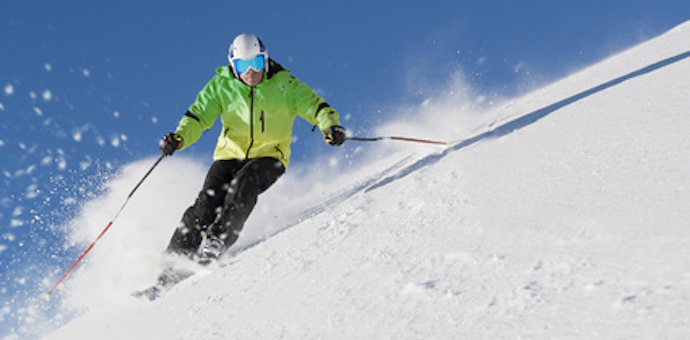
For serious skiers conditioning is an essential part of an overall ski training program. Not only will it allow athletes to perform at a superior level, it’s an important preventative measure to protect joints and connective tissue from injury.
From a sporting perspective (as opposed to a leisure activity), skiing events can be broadly grouped into one of five categories:
- Cross country skiing
- Downhill or alpine skiing
- Freestyle skiing
- Nordic combined
- Ski jumping
Snowboarding, while obviously not skiing, is now an Olympic sport and is covered in this section of the website.
Each discipline places their own unique and specific demands on the body; elite freestyle skiers typically having a very different physiological profile compared to cross country skiers for example.
Cross Country Skiing
Elite cross country skiiers rank amongst the top endurance athletes in the world for aerobic power (VO2max) (2,3). Aerobic capacity as well as onset of blood lactate accumulation can be used to predict success in this group of skiers (1,2,3).
Traditionally, endurance athletes and their coaches have opted for lower intensity and higher volume programs throughout the training year, with as little as 10% of training above the lactate threshold (3). However, it may be that a reduction in volume and an increase in high quality work can boost performance even in elite-level skiers (4). Even maximal strength training can improve work economy (5) and overall performance if converted to muscular endurance (6).
Alpine Skiing
The fitness profiles of alpine skiers differs significantly to their cross country counterparts. A great reliance is placed on anaerobic metabolism – power, power endurance and muscular strength (7). Even though moderate to high values for aerobic power are recorded in elite downhill skiers (8), this may be due to their training rather than a direct result of competing (7,9). Alpine skiers must be able to react quickly to changes in terrain and the course outline requiring agility, balance and co-ordination (6).
Downhill skiing forces the athlete into a crouched position placing significant strain on the knees. Not surprisingly, elite skiers have strong legs when measured during isometric and isokinetic leg extensions (8). Leg strength is also a predictor in downhill and giant slalom events (7).
In this section of the website you will find articles and sample training programs for skiing. A range of disciplines will be covered from snowboarding to cross country – all with reference to the latest research.
Ski Training Articles
Acclimatization to Altitude
What happens to our bodies several thousand meters above sea level? And can adaptations to altitude improve performance at sea-level?
Altitude Training
Performance at high altitude can be improved through altitude training. But what effect does living and training high have on sea-level performance?
Strength Training The Sport-Specific Way
Strength training has become an essential component in most athletes training program. Not only can it help to protect skiers from injury, it supports every aspect of performance in all the skiing disciplines
How To Design Resistance Training Programs For Athletes
Here is the step-by-step process of developing a sport-specific strength training plan – one that meets the demanding nature of skiing…
Core Strength Conditioning For Athletes
The muscles of the core region act as a link between the upper and lower body. The stronger and more ale they are, the greater the synergy of movement can be. Core strength is essential for skiiers…
Flexibility Exercises for Hockey
Increased flexibility may reduce the risk of certain injuries. It may also allow a hockey player to move with greater dexterity, agility and finesse…
Dynamic Stretches & Stretching Routine
Dynamic stretching is now recommended over static stretching before competition or training
Delayed Onset Muscle Soreness (DOMS)
We’ve all suffered it – the stiff, aching muscles that follow the first day of skiing or a long layoff. But can it be prevented or treated?
References
1) Larsson P, Olofsson P, Jakobsson E, Burlin L, Henriksson-Larsen K. Physiological predictors of performance in cross-country skiing from treadmill tests in male and female subjects. Scand J Med Sci Sports. 2002 Dec;12(6):347-53
2) Rusko HK. Development of aerobic power in relation to age and training in cross-country skiers. Med Sci Sports Exerc. 1992 Sep;24(9):1040-7
3) Ingjer F. Development of maximal oxygen uptake in young elite male cross-country skiers: a longitudinal study. J Sports Sci. 1992 Feb;10(1):49-63
4) Gaskill SE, Serfass RC, Bacharach DW, Kelly JM. Responses to training in cross-country skiers. Med Sci Sports Exerc. Vol. 31, No. 8, pp. 1211-1217, 1999
5) Hoff J, Helgerud J, Wisloff U. Maximal strength training improves work economy in trained female cross-country skiers. Med Sci Sports Exerc. 1999 Jun;31(6):870-7
6) Bompa TO. Periodization training for sports. 1999, Champaign: IL, Human Kinetics
7) Andersen RE, Montgomery DL. Physiology of Alpine skiing. Sports Med. 1988 Oct;6(4):210-21
8) Neumayr G, Hoertnagl H, Pfister R, Koller A, Eibl G, Raas E. Physical and physiological factors associated with success in professional alpine skiing. Int J Sports Med. 2003 Nov;24(8):571-5
9) Saibene F, Cortili G, Gavazzi P, Magistri P. Energy sources in alpine skiing (giant slalom). Eur J Appl Physiol Occup Physiol. 1985;53(4):312-6

Jacky has a degree in Sports Science and is a Certified Sports and Conditioning Coach. He has also worked with clients around the world as a personal trainer.
He has been fortunate enough to work with a wide range of people from very different ends of the fitness spectrum. Through promoting positive health changes with diet and exercise, he has helped patients recover from aging-related and other otherwise debilitating diseases.
He spends most of his time these days writing fitness-related content of some form or another. He still likes to work with people on a one-to-one basis – he just doesn’t get up at 5am to see clients anymore.